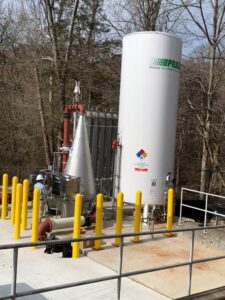Oxygen Injection for Odor Control: A Practical Option for Modern Collection Systems
 Odor control is becoming more important and more challenging for wastewater systems. As treatment facilities grow and surrounding areas develop, controlling odors is no longer optional. Utilities must meet stricter air quality rules, limit community complaints, and avoid corrosion in pipelines.
Odor control is becoming more important and more challenging for wastewater systems. As treatment facilities grow and surrounding areas develop, controlling odors is no longer optional. Utilities must meet stricter air quality rules, limit community complaints, and avoid corrosion in pipelines.
At Webster Environmental Associates (WEA), we help clients solve these problems using reliable and cost-effective methods. One option that works well in many modern systems is oxygen injection. This method helps reduce odors in force mains and pump stations while also lowering the need for strong chemicals.
Why Odor Forms in Force Mains
In wastewater collection systems, odors usually form when there’s no oxygen in the water. In these low-oxygen (anaerobic) conditions, bacteria switch to using sulfate for energy. This chemical process creates hydrogen sulfide, a gas that smells like rotten eggs and is highly corrosive.
The longer the water stays in the pipe without oxygen, the more hydrogen sulfide is produced. This gas escapes at pump stations, manholes, or air release valves and can damage equipment and nearby infrastructure. It also creates serious odor complaints from people who live or work near these systems.
How Oxygen Injection Works
Oxygen injection helps solve the problem at the source. By injecting dissolved oxygen into the wastewater upstream, we support aerobic conditions. This gives the bacteria what they need to work without switching to sulfate, stopping hydrogen sulfide from forming in the first place.
There are a few common ways to add oxygen. A Speece cone is one option. It uses high pressure to dissolve oxygen directly into the wastewater. Other systems include U-tube injection and venturi eductors, which mix oxygen into a sidestream and send it back into the main flow.
The goal is simple: keep the water aerobic long enough to prevent odor. When the system is designed correctly, oxygen injection works quietly and efficiently without major changes to how the plant operates.
When Oxygen Injection Makes the Most Sense
Oxygen injection is not the right choice for every site for industrial odor control, but it works especially well in specific situations. Long force mains are a good example. These pipes often have long detention times and few places where oxygen can be added. Injecting oxygen at the start can stop odor before it starts.
Remote locations are another good fit. In some areas, getting chemical deliveries like nitrate or iron salts can be expensive or unreliable. Oxygen injection systems can be run with fewer deliveries or even fully on-site oxygen generation.
Facilities that want to lower their long-term operating costs also benefit. While some chemicals are cheap to buy, they often require high doses and frequent handling. Oxygen, on the other hand, is easy to monitor, and the amount needed can be controlled precisely.
The Role of On-Site Oxygen Generation
Oxygen injection systems work best when paired with reliable oxygen supply. That’s why many facilities choose to generate oxygen on-site. Pressure Swing Adsorption (PSA) and Vacuum Swing Adsorption (VSA) systems both produce high-purity oxygen using standard compressed air.
These units separate oxygen from nitrogen using a molecular sieve. The result is a steady stream of oxygen that can be used directly in the injection system. PSA and VSA systems are simple to run and can be installed indoors or outside.
On-site generation cuts the need for liquid oxygen (LOX) deliveries. This improves safety, reduces cost, and makes operations more predictable. It also gives plant managers more control, especially in areas where LOX supply might be limited.
How WEA Helps Facilities Transition to Oxygen Injection
At WEA, we don’t believe in one-size-fits-all systems. We start by evaluating your specific collection system. That includes looking at pipe lengths, flow rates, and sulfide levels. We also consider current odor complaints and any existing treatment methods.
Based on this data, we design a system that fits your needs. We help select the right oxygen delivery equipment and decide on the best injection method. During installation, we work with your team to connect the system and verify it’s working properly.
Our support doesn’t stop after startup. We continue working with your staff to adjust the system as needed. That may include changes for seasonal flow variation or changes in upstream processes. We also provide help with monitoring and maintenance to keep the system running smoothly.
Plan Smarter for Long-Term Odor Control
Oxygen injection is a smart choice for many modern wastewater systems. It helps reduce odors at the source, prevents corrosion, and limits the need for harsh chemicals. It works especially well in long or remote pipelines where traditional treatments don’t always get the job done.
If your facility is dealing with rising odor complaints, high chemical costs, or corrosion in your collection system, oxygen injection might be the right next step. At Webster Environmental Associates, we can help you evaluate the problem and plan the right path forward.
Contact us today to learn more or schedule a site evaluation. Our team is ready to help you build a better odor control strategy that fits your operations and goals.
